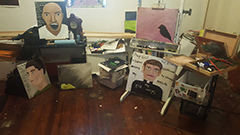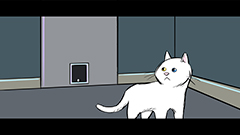IU East Senior Capstone Exhibition goes virtual April 30
For the first year in history, Indiana University East will host its Fine Arts Senior Capstone exhibition entirely online under the direction of Ann Kim, associate professor of fine arts. The exhibition, “Fear is Boring,” will open on Thursday, April 30, at iue.edu/gallery. A virtual reception will follow at 2 p.m. via Zoom at https://iu.zoom.us/j/91589605312.
The senior capstone works will also be displayed on the IU East Galleries Instagram page, @IUEastGalleries.
Kim is the chair of the Department of Fine and Performing Arts and is wrapping up her 11th year at IU East. She will be the first fine arts professor to conduct the annual student capstone exhibition, the event in which students display the bodies of work that they produced in the final course of their degree, entirely online during the last part of the semester.
The five seniors who will showcase their projects in the online exhibit include:
- Keith Conley, Economy, Indiana, fine arts major, “Self Portrait.”
- Josiah Free, Richmond, Indiana, fine arts major, “Sasha: The Escape Cat.”
- Kate McNew, Richmond, Indiana, fine arts major, “Agnes.”
- Rowen Perkins, Richmond, Indiana, fine arts major with a concentration in graphic design, “Huldra.”
- Brenna Wampler, Cambridge City, Indiana, fine arts major, “What is Love?”
The website, which will host the online exhibit, is an extension of the existing IU East gallery website. There, the public will have access to each student’s artist statement, biography, their websites created for the course, and images of their work.
The virtual reception will be held via Zoom, an online video conferencing service, and the public is encouraged to attend. “It’s also a chance for them to be able to get live feedback, which is often the biggest component of these receptions where people come to see your work in person,” Kim said.
Conley hopes to hear some of that feedback on his work.
“There is something to seeing and hearing what people think of something that you created,” said Conley.
The move to an online was necessary to provide the capstone seniors with the experience of an exhibition and reception. IU East Galleries on Instagram was created as a platform for all of the exhibitions online following the visitor restrictions to campus because of the coronavirus.
“We started it with the exhibition that is currently up on campus right now, which unfortunately was only able to be viewed for two days after it went up,” Kim said. “That’s the hard part, because in our discipline, everything is so physical.”
Kim is hopeful that being able to promote their work in an online space could be beneficial to her graduating seniors.
“I think this could be helpful for [the students], being able to promote their work in an online space, because you are able to share it with a wider audience,” Kim said.
“I feel like the reach of an online show is much greater than that of a physical show,” Conley said. He expressed his excitement about his project being displayed in the virtual exhibition.
Free had the same idea.
“I feel like presenting online will allow my work (and my classmates’ work) to potentially reach a wider audience,” Free said. “Not everyone wants to make a trip to campus to see an in-person exhibition, but anyone can view something online. The online exhibition might attract people who prefer viewing work in the comfort of their own home.”
Kim emphasizes the importance of learning to promote oneself as an art graduate, “that’s part of the self-promotion and marketing aspect that students have to work on, because they have to do the hustle themselves. As an artist, you are responsible for bringing people to your show.”
The capstone course requires that students create a website as a means of promoting themselves as artists. “Getting a bit more experience working in a virtual space is very important for the 21st century,” Kim said.
This year, it was Kim’s turn to teach the annual fine arts capstone course, which she says is, under normal circumstances, “basically impossible to teach in a 100 percent online format” because of the culmination of a physical exhibition at the end of the course. A typical capstone course will work as a trial, which gives art students the chance to see a project through from creation to installation to exhibition.
“I had to change gears in terms of…the focus of the exhibition. Towards the end, they would be learning how to install their own show,” Kim said. “Since we can’t do that, now there’s greater emphasis on how to document and edit their work so that they have the best images possible.”
The exhibition would normally take place in the IU East’s Tom Thomas Gallery in Whitewater Hall, giving students the experience of planning and executing a physical exhibition as part of the course.
“The negative [part] of this is that the installation component, they couldn’t really experience,” Kim said. “How do you measure out the space that you have? Where do you want to place things?”
The class is holding out hope that a face-to-face exhibition will be possible later in the year.
“Our goal is to be able to have an exhibition on campus once we are allowed to come back. The tricky part will be that we can’t require the students to participate in that at that point. Many of them will have graduated, some of them might not be living in Indiana, but I hope to be able to give that opportunity,” Kim said.
“I feel like the experience is somewhat lost with an online showcase. You can see the exact same thing online, but there’s just something special about being there in-person,” Free said. “It’s sort of like going to the movies. You can consume entertainment at home but going to a theater gives you an experience to remember.”
For Perkins, whose project is a ball-jointed doll made of clay, the switch to online relieved some of her worries about the presentation of her project.
“[My classmates’] projects in the gallery would take up a lot of room and have a lot of presence, and I knew that mine wouldn’t necessarily do that because it’s very small,” Perkins said. “Now that it’s online, I don’t have to worry about coming up with a real three-dimensional experience. I just need to have images that are satisfying, which is a lot easier to do with the nature of my project.”
The change to an all-online format is giving students real-world experience in how to adjust and make the best out of an uncontrollable situation.
“But overall, this is what artists train for. When the way that you have been doing things is interrupted, how do you problem solve and how do you make creative decisions? It’s about constantly evolving,” Kim said.
The move to an online course format has not always been ideal for students who are combining family, work, and student-life.
“I work in the studios as well as take the in-person studio classes, so when I am on campus, I am immersed in art not distracted about what is at home,” Conley said. “Now I am surrounded by constant distractions and trying to help my kids with their schoolwork. I feel like I spend half my day cooking.”
Free said being in class on campus provided resources he didn’t have, and now he is finding ways to continue his work at home.
“It’s easy to take for granted how much stuff we use on campus,” Free said. “For instance, I don’t have an easel at my house. Trying to draw on a large piece of paper is trickier in my room than in a studio.”
For Perkins, the switch to an online formatting meant not having access to resources that could better her project. “I wanted to rent a camera or check out a camera from Purdue Polytechnic Richmond, but I have a feeling I won’t be able to do that now. I’ll just have to make do with what I have.”
However, Kim is certain that the switch to a virtual exhibition could be a learning experience. Kim is leading by example and turned her dining room table into a make-shift art studio.
“We’re still doing all of the same components that we were working on, but it’s kind of also training, for how do you just keep making when things are not turning out as expected,” Kim said. “I think as a professor, it’s important that I am showing my students that I am making work through this, too.”
The seniors are coming up with their own ideas on how to adapt their home space or supplies on-hand to work on their art.
“The neat thing about art is that you can find a way to create something if you want to badly enough, even in less-than-ideal circumstances,” Free said.
Conley agreed.
“This is a reminder that in my career as an artist, I will have to be self-motivated and take the time to separate myself from my life to work,” Conley said. “It has an added emphasis on making good representation of my work in digital format, which will be great because for most shows and residencies, you submit examples of your work online with your application.”
Overall, Free is happy with the impact that the quarantine has had on his project.
“I still have to take my other assignments into consideration, but I can devote longer uninterrupted periods of time to working on my animation,” Free said.
Kim encourages her students to also find a routine.
“Try to find routine, I think routine is so helpful, and if you can bring a creative act into that routine, I think that’s even better. Use this chance to check on your friends or people who we were too busy to check on before,” Kim said. “You can make it into a positive experience.”
Aside from continuing their art work at home, a few of the students notes an opportunity to delve into new hobbies and skills.
“I kind of liked having my days in the studio, but working at home has been fine,” Perkins said. “I’ve learned how to sew and cook.”
Kim and her students are looking forward to the university’s first online exhibition and the virtual reception for the Senior Capstone. The community is encouraged to participate in the virtual reception because it’ll allow students the opportunity to celebrate their work in the company of others.
“Visit them, send them comments, or join us through our Zoom meeting. All of us want our work that we worked really hard on to be shown and shared,” Kim said.



